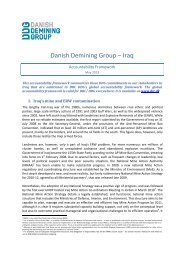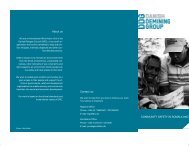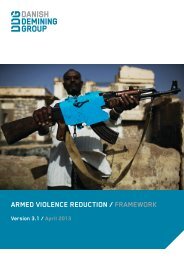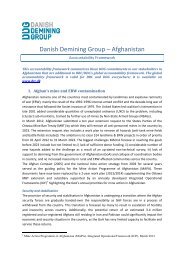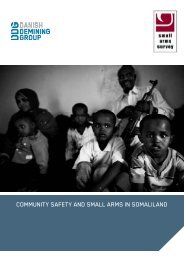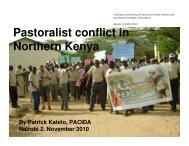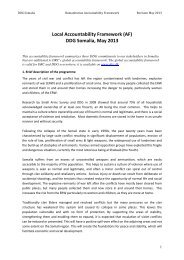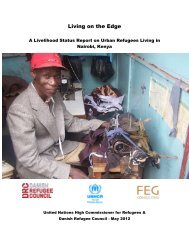8 DRC / DANISH REFUGEE COUNCIL2. Targeting of beneficiariesCash-based assistance can be most sustainable when identifying:Individuals with spending power,Productive individuals inside a household,In <strong>the</strong> winter, targeting those with <strong>the</strong> highest level of debts,Instead of targeting <strong>the</strong> most vulnerable who will be unable to sustain <strong>the</strong>mselves, hence creatingdependency on cash ra<strong>the</strong>r than cash as a means to an end. Similarly, <strong>the</strong> research finds that womenkeep <strong>the</strong> money in <strong>the</strong> household, but <strong>the</strong>y have little purchasing power. As such, targeting women toincrease household consumption might not be efficient, all <strong>the</strong> more as income is redistributed inside<strong>the</strong> household. However, as women and children have been identified as particularly exposed tohealth problems, providing vouchers or grants conditioned to visiting health facilities cash reach <strong>the</strong>double objective of allowing women to step out of <strong>the</strong>ir compounds and settlements, and positivelyimpact <strong>the</strong> health situation of households. Fur<strong>the</strong>rmore, targeting extremely vulnerable individualsunable to sustain <strong>the</strong>mselves – elderly, disabled, widows, children heads of households, for instance– outside immediate relief situations, creates fur<strong>the</strong>r dependency on assistance, and disturbstraditional mechanisms of redistribution. In all cases, involving <strong>the</strong> community in <strong>the</strong> elaboration ofcriteria by having community representatives and members check and validate each of <strong>the</strong>m,explaining what <strong>the</strong> objectives are and <strong>the</strong> rationale behind <strong>the</strong> criteria, making <strong>the</strong>m public in <strong>the</strong>camp, is essential to mitigate potential tensions and misappropriation of assistance.3. Determining <strong>the</strong> size of <strong>the</strong> grantGiven <strong>the</strong> high degree of assistance provided in <strong>the</strong> KIS, specific attention will have to be provided to<strong>the</strong> type of assistance offered and received by households, to assess <strong>the</strong> preferred objective of <strong>the</strong>grant and tailor its size accordingly. Cash grants can be calculated to be smaller and complementaryto existing assistance, or come as a helping hand after o<strong>the</strong>r forms of assistance to cover o<strong>the</strong>rneeds – such as small-scale investments as working capital, repayment of debts, access to healthcare and education, improving <strong>the</strong> consumption basket, to name a few.There is no one-size-fits-all approach, as grants can vary according to <strong>the</strong> size of <strong>the</strong> household.Typically, grants should be calculated on <strong>the</strong> basis of actual needs – ei<strong>the</strong>r based on averagemonthly incomes or on <strong>the</strong> average food consumption, in close cooperation with NGOs in a nearbyarea to avoid conflict and competition between programs.4. Securing cash distributionThere are four main mechanisms for delivering cash assistance in Afghanistan: Hawala, vouchers,mobile cash transfers and direct distribution. Given <strong>the</strong> accessibility of <strong>the</strong> KIS, handing out moneydirectly through NGO staff or implementing partner might be considered as a viable option. Alongwith <strong>the</strong> use of <strong>the</strong> Hawala system, direct cash transfer is <strong>the</strong> current preferred way of transferringmoney by NGOs implementing cash transfers in Afghanistan. Vouchers are <strong>the</strong>oretically more difficultto divert – and require <strong>the</strong> elaboration of adequate identification papers to fur<strong>the</strong>r mitigate this risk –and can be redeemed by <strong>the</strong> beneficiary at his or her convenience.As such, it is recommended that:On a short-term basis, direct distribution and vouchers remain <strong>the</strong> preferable solution, as KISsites are accessible by <strong>the</strong> field staff and do not present serious security concerns.On a longer-term basis, developing identification mechanisms to access hawala and M-PAISA services might prove a useful initiative.
CASH PROGRAMME REVIEW FOR IDPs IN KABUL INFORMAL SETTLEMENTS 9III.ConclusionsCan cash-based approaches work in <strong>the</strong> KIS? The answer is, undoubtedly, yes. Thanks to <strong>the</strong>ir urbanlocation, access to functional markets, and good security conditions, cash assistance does notpresent higher risks than o<strong>the</strong>r forms of assistance in <strong>the</strong> KIS.However, to be efficient, it will require a dual strategy:Short-term relief during <strong>the</strong> winter with cash as a complement to in-kind assistanceLong-term grants as a way out of poverty and to ensure sustainability of training programmes.Such an ambitious dual strategy implies taking into account specific camp situations, engaging withcommunities and making sure that NGO staff and <strong>the</strong> communities <strong>the</strong>mselves monitor all steps ofimplementation. Today and tomorrow, <strong>the</strong> volatile nature of security and <strong>the</strong> uncertainties of <strong>the</strong>economic environment combined with high political and media sensitivity surrounding interventionsin <strong>the</strong> KIS call for additional caution: objectives should be clear and transparent to limit possibletensions.More than coordinationThis will require – more than coordination – integrated M&E systems. Given <strong>the</strong> multidimensionalpoverty in <strong>the</strong> KIS, in o<strong>the</strong>r words <strong>the</strong> interrelatedness of different poverty indicators, cashprogramming will require building partnerships and a coordinated approach. Given <strong>the</strong> strongpresence of aid agencies in <strong>the</strong> KIS, a clear repartition of roles will be needed between partners. It iscertainly <strong>the</strong> time to test cash assistance in <strong>the</strong> gap and will this specific assistance ‘gap’ despite <strong>the</strong>high levels of aid (mainly food and NFIs) in <strong>the</strong> KIS. This role can be filled by DRC or by o<strong>the</strong>rstakeholders already involved in small-scale cash programmes. This will have to be <strong>the</strong> result ofdialogue and consultations among stakeholders to map out an effective way to share responsibilitiesand assign leadership roles. Stakeholders can build on <strong>the</strong> existing CaLP initiative and createoperational links across sectors – to use cash assistance as a means to help IDP households stepout of cycles of poverty and indebtedness, to increase <strong>the</strong>ir access not only to food, but health andeducation services, and providing a stronger sustainability to vocational and o<strong>the</strong>r trainingprogrammes currently being implemented.



